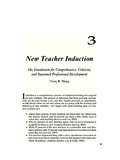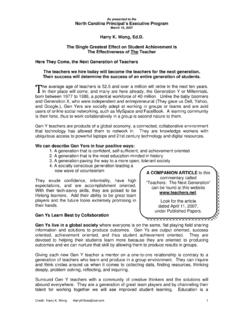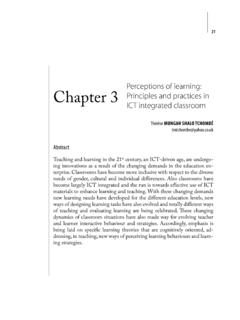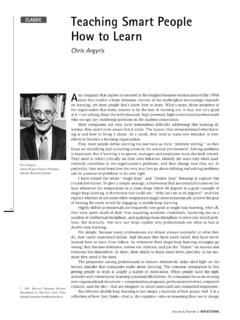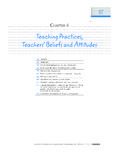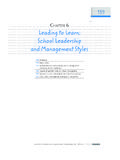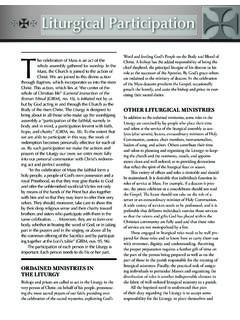Transcription of Induction Programs That Keep New Teachers Teaching and ...
1 NASSP Bulletin Vol. 88 No. 638 March 2004 41 Harry K. Wong is a former high school science teacher . He and his wife, Rosemary, are the authors ofThe First Days of is the co-author of New teacher Induction : How to Train, Support, andRetain New concerning this article may be sent to Programs that keep NewTeachers Teaching and ImprovingHarry K. WongThis article features schools and school districts with successful inductionprograms, all easily replicable. Increasingly, research confirms that teacherand Teaching quality are the most powerful predictors of student success. Inshort, principals ensure higher student achievement by assuring better teach-ing. To do this, effective administrators have a new teacher Induction pro-gram available for all newly hired Teachers , which then seamlessly becomespart of the lifelong, sustained professional development program for the dis-trict or school.
2 What keeps a good teacher are structured, sustained, inten-sive professional development Programs that allow new Teachers to observeothers, to be observed by others, and to be part of networks or study groupswhere all Teachers share together, grow together, and learn to respect eachother s Teachers hired today are the Teachers for the next success will determine the success of an entire generation of stu-dents. Their success can be ensured by providing them with a comprehen-sive, coherent professional development program. The ultimate purpose of any school is the success and achievement of itsstudents. Therefore, any efforts that are made must improve student achieve-ment. Improving student achievement boils down to the teacher . What theteacher knows and can do in the classroom is the most important factor re-sulting in student achievement.
3 Substantial evidence (Greenwald, Hedges, &Laine, 1996) shows that teacher qualification is tied to student that use value-added student achievement data have found that stu-dent achievement gains are much more influenced by a student s assignedteacher than other factors like class size and class composition (Darling-Hammond & Youngs, 2002). Effective Teachers manage to produce betterachievement regardless of which curriculum materials, pedagogical approach,or reading program is selected (Allington, 2003).Hanushek, Kain, and Rivkin (2001) found that the magnitude of theteacher effect is striking. Based on research in Texas, the importance of hav-ing an effective teacher instead of an average teacher for 4 or 5 years in a rowcould essentially close the gap in math performance between students from42 NASSP Bulletin Vol.
4 88 No. 638 March 2004low-income and high-income households. When he was at the University ofTennessee, William Sanders (1996) concluded that the children who had themost effective Teachers 3 years in a row posted academic achievement gainsthat were 54% higher than the gains of children who had the least effectiveteachers 3 years in a row. The Islip (NY) Public Schools (Wong, 2003a) implemented a 3-yearinduction program for new Teachers in 1999. They experienced a concomi-tant improvement in student achievement, which they view as resulting fromimproved teacher performance. The difference in student achievement isshown in Figure article is concerned with teacher Induction ; it is not about mentor-ing. A mentor is a component, albeit an important component, of an induc-tion program (see Figure 2).
5 Induction is a systemwide, coherent,comprehensive training and support process that continues for 2 or 3 yearsand then seamlessly becomes part of the lifelong professional developmentprogram of the district to keep new Teachers Teaching and improving towardincreasing their Difference Between Induction and Mentoring There is much confusion and misuse of the words mentoring and two terms are not synonymous, yet they are often used incorrectly. In-duction is a process a comprehensive, coherent, and sustained professionaldevelopment process that is organized by a school district to train, support,and retain new Teachers and seamlessly progresses them into a lifelong learn-ing program. Mentoring is an action. It is what mentors do. A mentor is a sin-gle person, whose basic function is to help a new teacher .
6 Typically, the helpis for survival, not for sustained professional learning that leads to becomingan effective teacher . Mentoring is not Induction . A mentor is a component ofthe Induction process (see Figure 3).The issue is not mentoring; the issue is mentoring alone. Mentors are animportant component, perhaps the most important component of an induc-tion program, but they must be part of an Induction process aligned to thedistrict s vision, mission, and structure. For a mentor to be effective, the men-tor must be used in combination with the other components of the in-duction process. In fact, in many Induction Programs , many of the mentorsare the trainers of the other components. However, for a mentor to be effec-tive, he or she must be trained to the mission and goals of the district.
7 Forinstance, Prince George s County in Maryland provides 40 hours of trainingfor each mentor. Forsyth County in Georgia provides 100 hours of trainingfor their Hopewell, Virginia, each new teacher has access to a variety of supporthelp. They each have a personal mentor to go to for immediate, simple helpNASSP Bulletin Vol. 88 No. 638 March 2004 43with procedural questions. An assigned mentor is especially important inhelping to ease anxiety quickly and serve as a confidante when needed. Thenew Teachers have access to four coaches in each school who have been train-ed and are compensated, each with expertise in classroom management andinstructional skills. On each campus, there are also five lead Teachers , alsotrained and compensated, with knowledge and skills in English, mathemat-ics, science, social studies, and technology.
8 In addition, the new Teachers re-ceive assistance from staff developers and administrators from both thecentral office and the building sites. Most important, there is an administra-tor who structures and coordinates the entire Induction the plethora of alternative certification Teachers , giving such a teach-er a mentor alone to meet on occasion is not sufficient. Thus, the EducationalCareer Alternative Program (ECAP) in Fort Worth, Texas, which is responsiblefor 1,000 alternative certification Teachers each year, provides intensive trainingwith a comprehensive array of subjects, followed by classroom support duringthe internship year. Support is provided by field advisers ( , former princi-pals, special education directors, superintendents, etc.) who observe classes frequently and can be contacted by e-mail or phone.
9 Principals applaud theprogram and even comment that they wish their regular Teachers could havethe same training and support, as it has proven to be a good Induction Dallas Public School s New teacher Initiative is a multifaceted pro-gram with a wide assortment of activities and people all integrated to helpteachers, especially the alternative certification Teachers . One facet of theinitiative is the instructional facilitators who act as an emergency 911 squadof 12 well-trained Teachers who will respond in less than 72 hours with ahouse call to the teacher who needs help. The facilitators work with thebuilding administration, department chairperson, and other Teachers tohelp the teacher in problem with many school districts is that their mentors are notpart of a mentoring program, much less an Induction program.
10 The mentoris simply a veteran teacher assigned by a principal. The North CarolinaTeaching Fellows Commission (1995) says, Giving a teacher a mentor only Figure 1. teacher Induction as a factor in student 1992 Before Induction 40% Regents diploma rate 80 students enrolled in Advanced Placement classes with 50% achieving 3 or higher2001 2002 After Induction 70% Regents diploma rate 120 students enrolled in Advanced Placement classes with 73% achieving 3 or higher44 NASSP Bulletin Vol. 88 No. 638 March 2004is a convenient and unconsciously foolish way for an administrator todivorce himself or herself from the leadership required to bring a begin-ning teacher up to professional maturity level. The Commission found thatprincipals and new Teachers rated mentoring the least effective way to helpnew Teachers .

